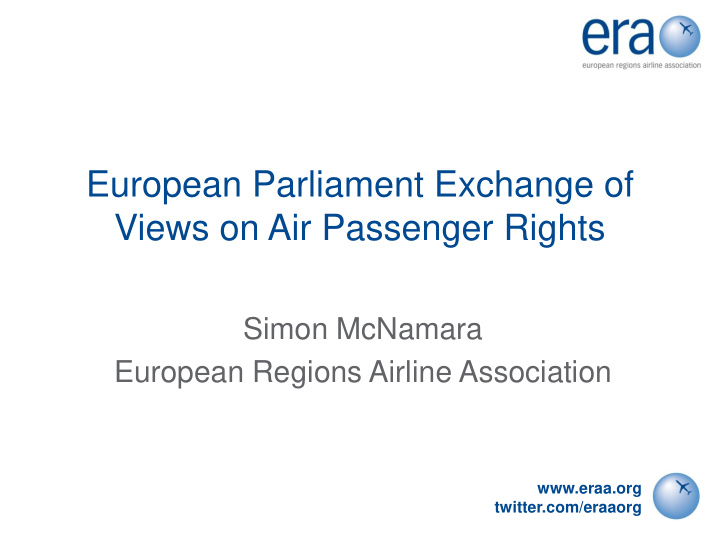



European Parliament Exchange of Views on Air Passenger Rights Simon McNamara European Regions Airline Association www.eraa.org twitter.com/eraaorg
About ERA • 51 airline members • 1.6 million flights per year • 70.6 million passengers per year • 72 minute average sector time • 72 seat average seating capacity Focused on intra-European, short haul flights by narrow body and regional aircraft www.eraa.org twitter.com/eraaorg
Amapola Flyg Atlantic Airways Belavia Air Alps Aviation Avion Express Wideroe DOT Mistral Air Belle Air Olympic Air Eastern Airways Aegean Airlines Blue 1 Regional Luxair Titan Airways Binter Canarias Aer Arann Sata Air Acores CityJet Air Nostrum Sky Work Airlines Blue Islands Suckling Airways PGA Portugalia Brit Air Astra Airlines Golden Air Montenegro Airlines Sky Express Trade Air Air Contractors Ireland Welcome Air Farnair Switzerland Air Iceland Denim Air ACMI West Air Sweden Airlinair Air Urga Aurigny Air Services Avanti Air Eurolot BMI Regional Estonian Air Malmo Aviation Darwin Airlines KLM Cityhopper Carpatair Cimber www.eraa.org Danish Air Transport twitter.com/eraaorg
EU261 as it stands now We welcome the opportunity to improve EU261 where: • It provides greater clarity • It improves the fair application of the Regulation • It provides real additional rights • It re-balances passenger rights with airline obligations Some parts of the proposal by the Commission achieve this, others do not … www.eraa.org twitter.com/eraaorg
Pros and Cons… This presentation will focus on three issues of concern for ERA members: Liability for compensation in the event of long arrival (at final destination) delays in the case of connecting flights (Article 6a) Delay at final destination (Article 6, par. 2) Diversions considered as cancellations (Article 2l) www.eraa.org twitter.com/eraaorg
Connecting flights matter.. • The “ Hub & Spoke ” concept is still a major part of connecting Europe’s regions with the world www.eraa.org twitter.com/eraaorg
Missed connecting flights Case study Faroe Islands – Copenhagen – Tokyo • First Leg: a regional airline • Second Leg: a network airline • A small delay (45 mins) on leg 1 causes a missed connection in Copenhagen • Copenhagen-Tokyo: passenger is re-routed on the next day’s flight and reaches Tokyo with a 24hour delay www.eraa.org twitter.com/eraaorg
Missed connecting flights (the situation today) Faroe Islands – Copenhagen – Tokyo Passenger is already protected by: • 1999 Montreal Convention: recovery in case of damages to passengers and luggage caused by the delay in the air carriage • Multilateral Interline Traffic Agreements (MITA): over 350 worldwide IATA and non- IATA airlines’ network covered: First leg operator: responsible for re-routing, care/assistance at transit • MITA: internationally well-established agreements; care and assistance is what disrupted passengers need An unhappy passenger? YES www.eraa.org An abandoned passenger? NO twitter.com/eraaorg
Missed connecting flights (proposed art.6a) Faroe Islands – Copenhagen - Tokyo Compensation due by first leg operator (regional): • Disproportionate: based on “Faroe - Tokyo” distance • Inconsistent: punitive although connecting delay is below the “long delay” threshold level normally triggering compensation • Disincentive to interlining agreements (MITA): Hub & Spoke principle damage European Regions potentially isolated from the hubs and therefore from the world Multiple luggage check-ins and tickets An unhappy passenger? YES www.eraa.org An abandoned passenger? YES twitter.com/eraaorg
Delay at final destination (art. 6, par. 2) London ‐ Dubai ‐ Bangkok : • First leg: an EU air carrier arrives on time • Second leg: a non ‐ EU air carrier and arrives late For compensation purposes, (long) delay is now considered at final destination Who pays? • Paradox 1: First carrier has to pay compensation although it provides a service with no delay? Unfair • Paradox 2: Second carrier has to pay compensation although flight out of the scope of the Regulation? Unenforceable www.eraa.org twitter.com/eraaorg
Flight diversions as cancellation (art. 2, letter l) “… A flight where the aircraft took off but, for whatever reason, was subsequently forced to land at an airport other than the airport of destination or to return to the airport of departure, shall also be considered a cancelled flight” . • Flight safety is and must always be the number one priority for air operators • Airlines will always make prudent decisions to divert when necessary, always for flight safety reasons • Does this amendment potentially pose a threat to safety by providing a disincentive to divert?? Passenger safety must always come first www.eraa.org twitter.com/eraaorg
Summary • Article 6a ( missed connecting flights ): passengers’ protection (MITA) poorer; EU regions connectivity to the hubs reduced; inconvenience to passengers increased (multiple luggage check-in, multiple tickets for one journey) Inconsistent with long-established airlines cooperation Inconvenience at airports: increased transit of passengers • Article 6, par. 2 ( long delay at final destination ) May impose compensation despite punctuality; May be unenforceable; • Article 2l ( flight diversions ): No compromise on safety is acceptable No challenge to a captain’s decision taken exclusively on safety grounds www.eraa.org twitter.com/eraaorg
Recommend
More recommend